8 Types of Ticks on Dogs
There are several species of ticks that feed on dogs and new species still being discovered. If you find a tick on your dog, it is important to identify it to learn the most common diseases that this species may transmit and what symptoms your dog may display if a disease is transmitted.
This article will cover the most common species of ticks that affect dogs and the types of diseases they can carry.
What Are Ticks?
Ticks are eight-legged bloodsucking external parasites that can be found worldwide. Some ticks feed by biting dogs to obtain a blood meal. Ticks prefer to live in warm and humid environments, and certain species may only be found in specific regions of the United States. Global warming and other environmental factors have aided in a higher density of ticks, migration of ticks to new regions, and an increased rate of tick-borne diseases.
Ticks can carry a variety of serious diseases by harboring certain types of bacteria in their bodies. Not all ticks carry diseases, but some ticks carry more than one. After feeding for a certain length of time, an infected tick releases bacteria through its saliva into a dog, causing the dog to acquire a tick-borne disease.
Diseases transmitted by a tick bite include:
Eight Tick Types Often Seen on Dogs
Lone star tick (Amblyomma americanum)
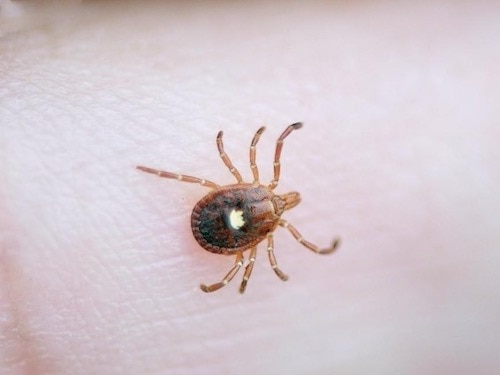
Photo Credit: iStock/Joesboy
- Location: Eastern and Southeastern United States
- Diseases transmitted: Ehrlichia, Rickettsiosis, Tularemia
Eastern black-legged or deer tick (Ixodes scapularis)

Photo Credit: iStock/Northeast Regional Center for Excellence in Vector-Borne Diseases
- Location: Eastern United States
- Diseases transmitted: Lyme disease, Anaplasma, Ehrlichia, Rickettsiosis
Brown dog tick (Rhipicephalus sanguineus)
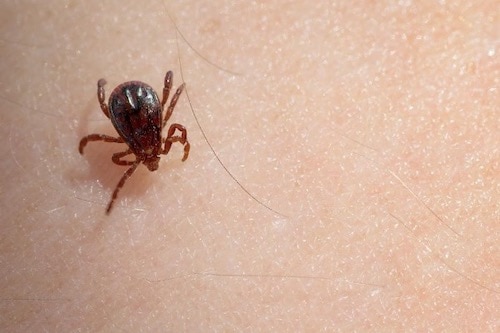
Photo Credit: iStock/RobertAx
- Location: Throughout the United States, except for Alaska
- Diseases transmitted: Babesia, Ehrlichia, Anaplasma, Bartonella, Rocky Mountain spotted fever, Hepatozoonosis
Asian longhorned tick (Haemophysalis longicornis)
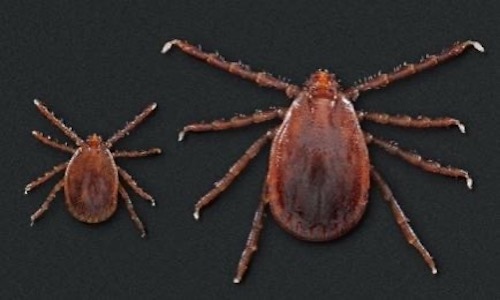
Photo Credit: US Centers for Disease Control and Prevention
- Location: North Carolina, Virginia, West Virginia, New Jersey, New York, Connecticut, Kentucky, Tennessee, Rhode Island, Delaware, and Ohio. More research is being conducted to determine if this tick is in other states.
- Diseases transmitted: This tick was first discovered in the US in 2017, and it is unknown if this tick transmits disease to dogs. In a laboratory setting, this tick was able to transmit Rocky Mountain spotted fever. More research is being done to further determine what diseases, if any, these ticks can transmit to dogs.
Gulf Coast tick (Amblyomma maculatum)
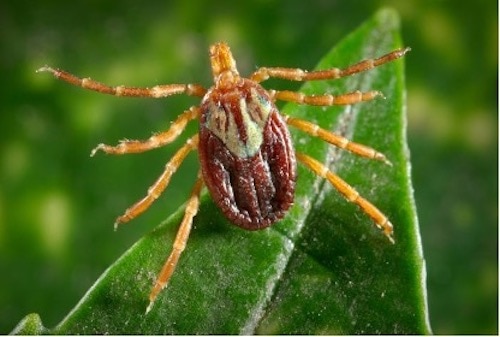
Photo Credit: National Environmental Health Association
- Location: Coastal states along the Gulf of Mexico and Atlantic Coast and as far north as Maryland
- Diseases transmitted: Tick paralysis, American canine Hepatozoonosis, Rickettsiosis
American dog tick (Dermacentor variabilis)

Photo Credit: iStock/dbstudio
- Location: California and east of the Rocky Mountains
- Diseases transmitted: Ehrlichia, Rocky Mountain spotted fever, Tularemia
Rocky Mountain wood tick (Dermacentor andersoni)
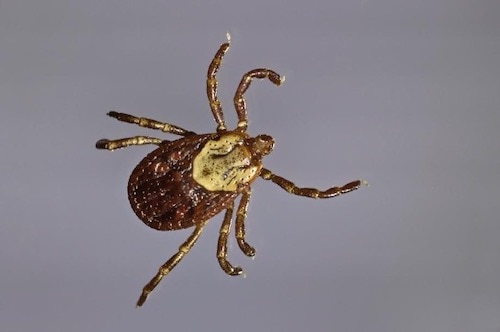
Photo Credit: iStock/ milehightraveler
- Location: Rocky Mountain states
- Diseases transmitted: Rocky Mountain spotted fever, Tularemia
Western black-legged or deer tick (Ixodes pacificus)
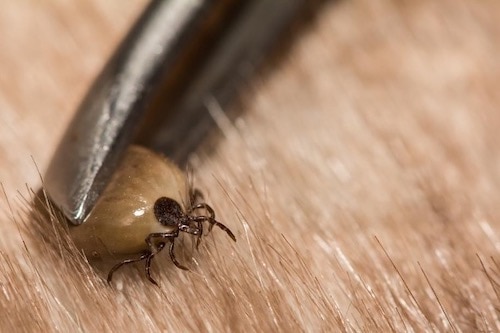
Photo Credit: iStock/Jason Ondreicka
- Location: States along the Pacific coast, Arizona, Nevada, and Utah
- Diseases transmitted: Lyme disease, Anaplasma
Symptoms of Tick Infestation
Ticks are sneaky. They release a substance within their saliva that makes their bite painless. Dogs usually do not feel a tick biting or feeding on them, and therefore show no symptoms. However, if a tick is in the ear or between the toes, the dog may respond by shaking the head or licking or chewing at the foot.
If a tick transmits Ehrlichia or anaplasma, these tick-borne diseases can cause bleeding disorders. A dog with either of these diseases may start to have nosebleeds or develop small reddish to purplish lesions on the skin or gums, called petechiae. It is important to monitor your dog’s skin for these lesions if you find a tick on your dog. Petechiae can be better seen in areas that have little to no fur, such as the belly, ear flaps, gums, and armpits.
Some tick-borne diseases can cause enlarged lymph nodes, lethargy, and fever. Lyme disease can also cause a shifting leg lameness. Symptoms of tick diseases may not develop for days or weeks after the tick bite, depending upon the type of disease that is transmitted.
If dogs develop tick paralysis from a tick feeding on them, symptoms usually develop after the tick has been feeding for at least 5 days. Neurological symptoms, such as paralysis in all four legs, inability to blink, and loss of jaw tone can develop and progress quickly within 24-48 hours of when symptoms develop. Treatment involves removal of the tick, and symptoms usually resolve within 2-3 days. However, recovery may take longer depending upon how long the tick was feeding prior to being removed.
What Is the Life Cycle of a Tick?
Ticks mature through four life stages:
-
Egg
-
Larval
-
Nymph
-
Adult
It can take up to 2 years for their life cycle to be complete, as they require a new host during each stage of development. Female ticks generally live for 2 years. Male ticks die after they mate.
Ticks in the larval or nymph phases are very tiny and can be overlooked on a dog’s body. The larval stage has six legs and is equivalent in size to a grain of sand; a nymph has eight legs and is the size of a poppy seed or freckle. These ticks are very difficult to find and can hide well.
Adult ticks are larger but vary in size and appearance based on the species of tick. They can be the size of an apple seed, but female ticks that are engorged (filled with blood from feeding) are easier to find, they can be the size of a small grape.
Tick Prevention for Dogs
It is important to administer flea/tick prevention to your dog year-round, and the Centers for Disease Control (CDC) recommends checking your dog for ticks every day. Ticks are becoming more prevalent due to global warming. Flea and tick prevention and screening your pet daily for ticks is important to reduce risk of itchy tick bites and tick diseases.
Washing your clothing after outdoor activities such as hiking and camping can also reduce the risk of ticks entering your house and finding a new host, such as your pet. If ticks are prevalent in your area, you can contact a licensed pest control operator to treat your yard for ticks. However, make certain the operator is aware of any pets you have, and ask when it will be safe for your pets to go back into the yard after it is treated.
References
-
Centers for Disease Control and Prevention. Ticks. May 2021.
-
Companion Animal Parasite Council. Ticks. April 2017
-
Division of Environmental Health: Alaska. Tick Identification.
-
Northeast Regional Center for Excellence in Vector-borne Diseases. Asian Longhorned Tick (Cattle Tick or Bush Tick).
Featured Image: iStock.com/knape
